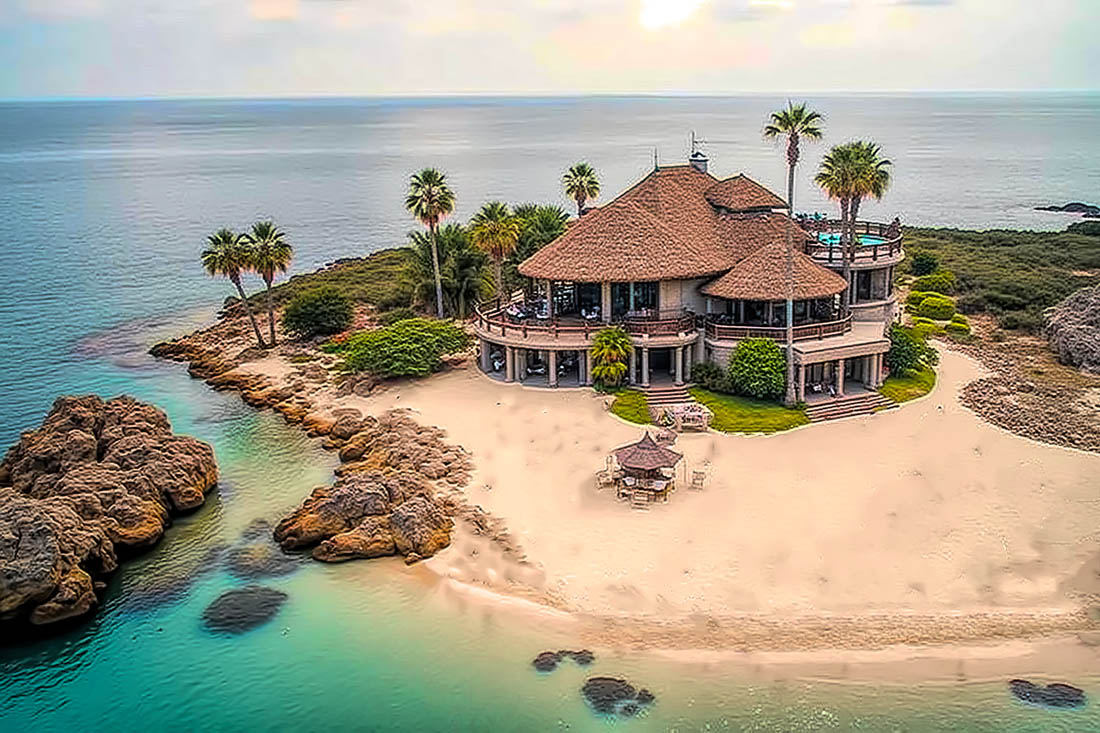
Buying Your Own Island: Fantasy vs. Reality
The Complete Guide to Prices, Factors, and Ownership
Owning a private island has long been a dream associated with luxury, exclusivity, and ultimate privacy. From celebrities and billionaires to ambitious entrepreneurs and eco-resort developers, the allure of having your very own island paradise remains powerful. But the burning question for many people is straightforward: how much does a private island cost?
The answer is more complex than you might expect. Prices vary enormously depending on location, size, accessibility, natural resources, and whether the island comes with existing infrastructure. A small undeveloped island in Central America might be available for under $200,000, while prime private islands in the Caribbean or Mediterranean can exceed $50 million.
In this article, we’ll explore the different factors that affect private island prices, examine regional price ranges, look at real-world examples, and discuss the hidden costs of ownership. By the end, you’ll have a detailed understanding of what it really costs to buy, and maintain, a private island.
Why People Buy Private Islands
Before diving into the numbers, it helps to understand why people invest in private islands in the first place. The motivations influence not only what type of island they buy but also how much they’re willing to spend.
Privacy and exclusivity: A private island offers total seclusion, something that no villa, penthouse, or luxury hotel can fully guarantee.
Investment potential: Some islands appreciate significantly in value, especially when tourism demand in a region increases.
Tourism development: Investors buy islands to create eco-resorts, luxury retreats, or adventure destinations.
Personal legacy: For some buyers, an island is a family retreat passed down through generations.
Status symbol: Like yachts or rare art, islands represent a symbol of extreme wealth and influence.
These goals shape the budget and type of island buyers pursue.
How Much Does a Private Island Cost?
The price of a private island is determined by location, size, infrastructure, and legal conditions. Generally, the cost ranges between $200,000 and $100 million. While some smaller undeveloped islands may cost less than a suburban home, the world’s most desirable islands in the Bahamas, French Polynesia, or the Mediterranean command prices comparable to skyscrapers in major cities.
Let’s break down the major factors.
Key Factors That Determine Private Island Prices
1. Location
Location is the single most important factor. Islands in highly desirable regions with stable governments and easy international access cost significantly more than remote or politically unstable locations.
Caribbean: Known for turquoise waters, proximity to North America, and high demand, Caribbean islands are among the most expensive.
Mediterranean: Limited supply, stunning scenery, and proximity to Europe make Mediterranean islands incredibly costly.
Southeast Asia & Pacific: Prices vary widely, but islands in Thailand, Fiji, or French Polynesia are attractive to resort developers.
Canada & Northern Europe: Beautiful but seasonal islands often cost less due to colder climates and shorter tourist seasons.
2. Size of the Island
A 2-acre island might only fit a small house and dock, while a 200-acre island could host a resort, airstrip, and extensive infrastructure. Larger islands generally cost more, though price per acre can sometimes be lower.
3. Infrastructure
An undeveloped island without utilities, housing, or docks is much cheaper than one with modern villas, power generation, water systems, and internet access. Developing infrastructure on a remote island can cost millions.
4. Accessibility
Islands close to mainland airports, harbors, or popular tourist hubs cost more than isolated ones requiring long boat rides or seaplanes. Accessibility greatly affects usability and resale value.
5. Legal and Ownership Status
Some islands can only be leased, not owned outright. Others have restrictions on development. Islands with clear freehold ownership are more expensive because they provide security and flexibility.
6. Natural Resources and Features
Freshwater sources, beaches, elevation (protection from rising seas), and fertile soil add value. A barren rocky outcrop with no water is far less desirable than a lush island with natural harbors and white sand.
Regional Price Ranges for Private Islands
Caribbean & Bahamas
Typical range: $500,000 – $50 million+
The Bahamas are world-famous for private island sales. A modest undeveloped island might start around $500,000, while fully developed luxury resorts can exceed $40–60 million.
Central America
Typical range: $200,000 – $5 million
Countries like Belize, Panama, and Nicaragua offer relatively affordable private islands. However, infrastructure is often lacking, and development regulations vary.
North America (USA & Canada)
Typical range: $300,000 – $10 million
Maine, Nova Scotia, and British Columbia have affordable islands, but many are seasonal due to cold weather. Florida Keys islands are far more expensive, often in the multi-million range.
South Pacific
Typical range: $500,000 – $20 million
Fiji, French Polynesia, and Vanuatu have islands popular with eco-tourism investors. Stunning but sometimes limited by leasehold ownership rather than freehold.
Mediterranean (Greece, Italy, Spain, Croatia)
Typical range: $2 million – $100 million+
Extremely high demand and limited availability push Mediterranean islands into the ultra-luxury tier. Some of the most expensive islands in the world are located here.
Indian Ocean (Maldives, Seychelles, Mauritius)
Typical range: $1 million – $50 million
Popular with luxury resorts, but many islands are government-leased, not freehold.
Real-World Examples of Private Island Prices
Small Caribbean Island (Belize): Around 1.5 acres, undeveloped, priced at $300,000.
Turnkey Bahamas Island: 20 acres with luxury villas, marina, and power, priced at $25 million.
Greek Island: 100+ acres, undeveloped but near major shipping lanes, priced at $15 million.
Canadian Lake Island: 5 acres, private cottage, seasonal access, priced at $500,000.
Ultra-Luxury Maldives Resort Island: Fully developed with overwater bungalows, priced at $40 million+.
These examples illustrate the diversity of pricing, depending heavily on development and geography.
Hidden Costs of Owning a Private Island
Buying the island is just the beginning. Ownership brings significant ongoing expenses:
Infrastructure Development: Building docks, solar panels, water treatment, and housing can cost millions.
Maintenance: Staff salaries, boat fuel, repairs, and upkeep can exceed hundreds of thousands annually.
Transportation: Operating boats or seaplanes to access the island adds to costs.
Legal & Administrative Fees: Taxes, permits, environmental impact studies, and legal paperwork are essential.
Insurance: Insuring an island against storms, floods, or accidents is costly, especially in hurricane-prone regions.
For many owners, annual running costs can range from 2% to 10% of the island’s purchase price.
Leasing vs. Owning an Island
In some regions, outright ownership is impossible, and only long-term leases (often 50–99 years) are available. This is common in the Maldives, Fiji, and parts of Southeast Asia. Leasehold islands are cheaper but come with limitations. Buyers looking for long-term family assets usually prefer freehold islands in places like the Caribbean, North America, or parts of Europe.
Are Private Islands a Good Investment?
Like any real estate, islands can appreciate in value. However, they are less liquid than traditional property, selling an island may take years. Investment potential is strongest when:
The island is in a growing tourism market.
Infrastructure development is possible.
Accessibility is convenient.
The region has political and economic stability.
For developers, islands can become lucrative eco-resorts or luxury retreats. For individuals, financial returns may be secondary to lifestyle benefits.
How to Buy a Private Island
Set a Budget: Realistically assess both purchase and ongoing costs.
Choose a Region: Narrow down by climate, language, accessibility, and legal rules.
Work with Specialists: Use reputable brokers experienced in island transactions.
Verify Ownership: Ensure titles are clear and not under dispute.
Conduct Environmental Assessments: Check for risks like erosion, rising sea levels, or protected ecosystems.
Plan for Access & Utilities: Consider docks, runways, water supply, and power.
Negotiate & Close: Work with legal experts familiar with the country’s property laws.
Common Misconceptions About Private Island Prices
“Islands are only for billionaires.”
Not true, some islands cost less than a city apartment.“All islands come with sandy beaches.”
Many are rocky or mangrove-covered, limiting recreational use.“Owning an island means complete freedom.”
Governments often regulate what you can build or how land is used.“Maintenance is cheap.”
In reality, running costs can be significant, especially for remote islands.
Lifestyle Benefits of Island Ownership
For those who can afford it, the benefits extend beyond exclusivity:
Total Privacy: A sanctuary away from crowds and paparazzi.
Connection to Nature: Fishing, diving, and untouched ecosystems at your doorstep.
Family Legacy: A retreat to pass down through generations.
Creative Projects: Many artists, writers, and entrepreneurs find inspiration in isolation.
Hosting & Business: An island can be a venue for retreats, weddings, or luxury rentals.
The Future of Private Island Prices
Climate change, rising sea levels, and global demand for luxury tourism are shaping the market. Islands in safe regions with higher elevation and sustainable infrastructure are expected to rise in value. Meanwhile, low-lying islands in hurricane-prone areas may face declining demand unless major investment in protection is made.
How Much Does a Private Island Really Cost?
The cost of a private island can be as little as $200,000 for a small undeveloped property or more than $100 million for a luxury paradise in the most coveted regions. The final price depends on location, size, infrastructure, and ownership rights.
For most buyers, the purchase price is just the beginning, ongoing maintenance, staffing, and transportation add significant expenses. Still, for those with the means, owning a private island remains one of the most exclusive lifestyle investments in the world.
Whether you’re dreaming of a modest off-grid retreat or a fully developed resort, the range of options is broader than many imagine. The real question is not just how much does a private island cost, but how much are you willing to invest in the dream of absolute privacy and paradise?




